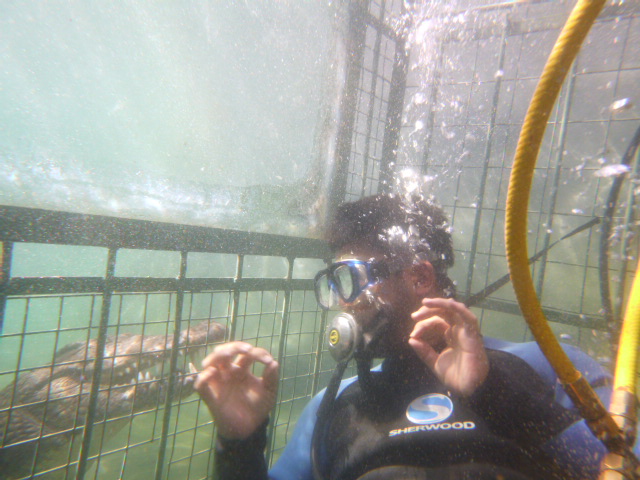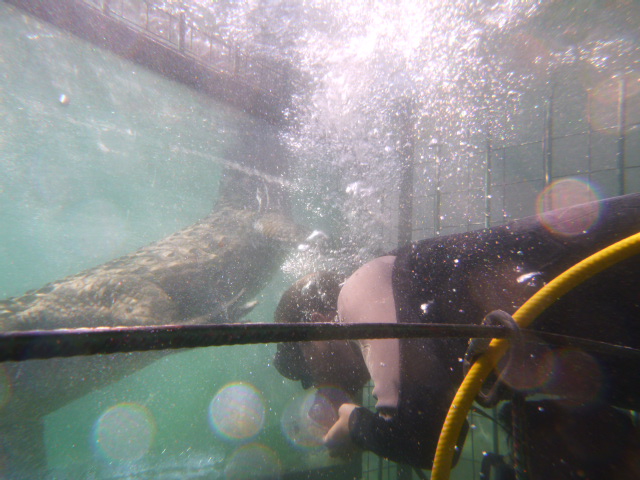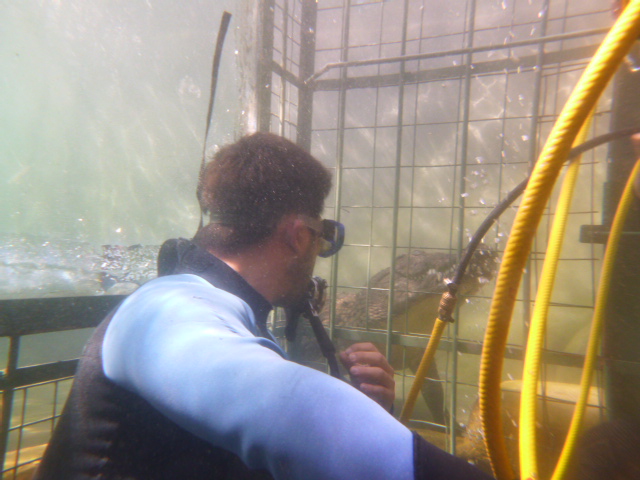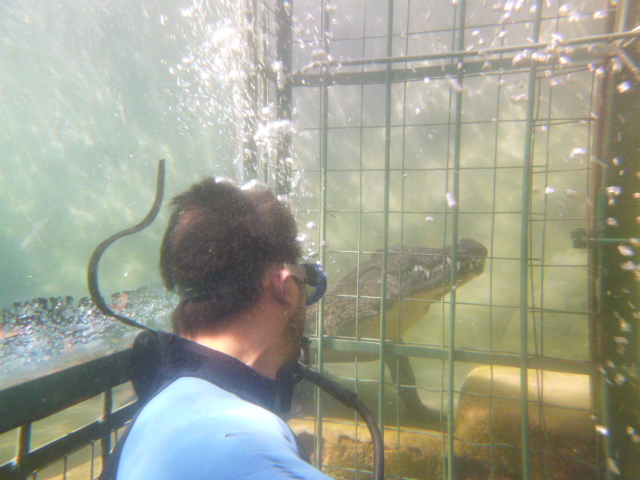Thrill-seekers take note: there’s a new way to stare death in the eye. It’s called crocodile cage diving, and right now there are only three places on Earth where you can do it. It involves suiting up in scuba gear and jumping into an ice-cold pool that’s home to the king of the reptiles. And. It. Is. Awesome.
“The beauty of sunlight once you’re in the water really brings these ancient predators to life,” says Sandi Nielsen, who helps run Predator Diving in Victoria Falls, Zimbabwe. In front of us, three enormous crocs lazily sunned on the edge of a swimming pool while Neilsen went over safety instructions.
First and foremost, the crocs enter the water because they are looking for food. So, don’t put you your hands through the grate. You will be able to touch its stomach if one swims above you. If you panic, you can surface in this one-foot cage box that stays above ground, but the croc might follow you. And, she goes over all manners of safety that come along with breathing through a scuba regulator.
Things start getting real when you’re in Africa and inside a cage that’s submerged in a swamping pool full of crocs, who have the strongest bite of any animal in the world. The biggest guy in our group has second thoughts. Claustrophobia he says. And it’s hard to control breathing in a regulator, especially because the water is colder than an ALS Ice Bucket Challenge and instinctively makes you breathe faster. The freezing water, we are told, is for our own safety. It makes the beasts more lethargic. But they will soon have a solar powered heater to make it a little more comfortable for divers.
“We do this in a swimming pool because the river is too murky,” Neilsen explains. She and her husband Brian have worked with crocs since 2010 when they moved here from Australia. Brian and a group of friends caught the crocs by hand in the waters around the nearby Zambezi River—Bongo, Prado and Lucky. “We have regular inspections from a wildlife vet who says these guys are more than happy to lie around in the sun and enjoy the fast food.” She talks of them with the love and affection of a pet owner. “They lay eggs every October in a sand pit we’ve built for them.” The facilities look well taken care of and the crocs don’t at all seem stressed out.
“We don’t force them to go in,” says Nielsen, though they associate the cage with food, so at least one or two of the crocs will be in the water with you at any given time. There are no more than four people in the cage—two in the front and two in the back, including a photographer, charged with taking your next Facebook profile image. There’s a plexiglass window in the cage you can swim in front of to get clear shots. The cage sinks until there’s about a foot of water over head. From there, it’s you and about 25 minutes of convening with the crocs in their preferred, watery habitat.
The time goes quickly. I spent the majority of it in a staring competition with the creature. Its craggy maw is a menacing smile, like it’s laughing at you for evolving a body that’s way too easy to eat with no natural defense and a puny set of jaws. Some food dropped in and we observed it ravaging the meat. But you really see the nature of this 250 million-year-old predator, in it’s glassy, marble, Darth Vader eyes. The onyx orbs radiate with a hunger for life – your life – and with the cool assurance of a serial killer I can hear its thoughts, “I can and will eat you,” they say. “And if that cage doesn’t go away, I’ll eat you with my stare.” It swam overhead. We touched its belly. And then it was over.
Like how a victim starts to revere its tormenter, we walked away feeling respect towards crocodiles.
Predator Diving s $70 per person and is the first cage-only croc dive in the world. The newest opens this September on Cango Ranch, in Cape Town, South Africa. Crocosaurus Cove is the first company to offer enclosed, underwater experiences with crocs can be found in Darwin, Australia and was launched in 2008. They use a see through plexiglass tube. Pique Travel can help organize your trip to Zimbabwe and other African countries.
Lead Image: From Cango Ranch. In Story: From Predator Diving






